Gene Expression Programming Model for Tribological Behavior of Novel SiC–ZrO2–Al Hybrid Composites
Abstract
1. Introduction
2. Experimental and Method
2.1. Fabrication of Composites
2.2. Gene Expression Programming
3. Results and Discussion
4. Conclusions
Author Contributions
Funding
Informed Consent Statement
Data Availability Statement
Acknowledgments
Conflicts of Interest
References
- Ravindran, P.; Manisekar, K.; Narayanasamy, P.; Selvakumar, N.; Narayanasamy, R. Application of factorial techniques to study the wear of Al hybrid composites with graphite addition. Mater. Des. 2012, 39, 42–54. [Google Scholar] [CrossRef]
- Sharma, P.; Sharma, S.; Khanduja, D. A study on microstructure of aluminium matrix composites. J. Asian Ceram. Soc. 2015, 3, 240–244. [Google Scholar] [CrossRef]
- Baradeswaran, A.; Vettivel, S.; Perumal, A.E.; Selvakumar, N.; Issac, R.F. Experimental investigation on mechanical behaviour, modelling and optimization of wear parameters of B4C and graphite reinforced aluminium hybrid composites. Mater. Des. 2014, 63, 620–632. [Google Scholar] [CrossRef]
- Narayanasamy, P.; Selvakumar, N. Effect of hybridizing and optimization of TiC on the tribological behavior of Mg–MoS2 composites. J. Tribol. 2017, 139, 051301. [Google Scholar] [CrossRef]
- Narayanasamy, P.; Selvakumar, N. Tensile, compressive and wear behaviour of self-lubricating sintered magnesium based composites. Trans. Nonferrous Met. Soc. China 2017, 27, 312–323. [Google Scholar] [CrossRef]
- Kern, F.; Palmero, P.; Marro, F.G.; Mestra, A. Processing of alumina–zirconia composites by surface modification route with enhanced hardness and wear resistance. Ceram. Int. 2015, 41, 889–898. [Google Scholar] [CrossRef]
- Arif, S.; Alam, M.T.; Ansari, A.H.; Siddiqui, M.A.; Mohsin, M. Study of mechanical and tribological behaviour of Al/SiC/ZrO2 hybrid composites fabricated through powder metallurgy technique. Mater. Res. Express 2017, 4, 076511. [Google Scholar] [CrossRef]
- Kök, M.; Özdin, K. Wear resistance of aluminium alloy and its composites reinforced by Al2O3 particles. J. Mater. Process. Technol. 2007, 183, 301–309. [Google Scholar] [CrossRef]
- Baskaran, S.; Anandakrishnan, V.A.; Duraiselvam, M. Investigations on dry sliding wear behavior of in situ casted AA7075–TiC metal matrix composites by using Taguchi technique. Mater. Des. 2014, 60, 184–192. [Google Scholar] [CrossRef]
- Ravindran, P.; Manisekar, K.; Rathika, P.; Narayanasamy, P. Tribological properties of powder metallurgy–Processed aluminium self lubricating hybrid composites with SiC additions. Mater. Des. 2013, 45, 561–570. [Google Scholar] [CrossRef]
- Tan, A.; Teng, J.; Zeng, X.; Fu, D.; Zhang, H. Fabrication of aluminium matrix hybrid composites reinforced with SiC microparticles and TiB2 nanoparticles by powder metallurgy. Powder Metall. 2017, 60, 66–72. [Google Scholar] [CrossRef]
- Yadav, R.K.; Hasan, Z.; Ansari, A.H. Investigation of mechanical and wear behavior of Al based SiC reinforce metal matrix composite. Mater. Today Proc. 2020, 21, 1537–1543. [Google Scholar] [CrossRef]
- Zeraati, M.; Kazemzadeh, P.; Barani, M.; Sargazi, G. Selecting the appropriate carbon source in the synthesis of SiC nano-powders using an optimized Fuzzy Model. Silicon 2022, 14, 2953–2964. [Google Scholar] [CrossRef]
- Zeraati, M.; Tahmasebi, K.; Irannejad, A. Formation of SiC nanocrystals prepared by sol-gel processing of green carbon sources and DFT calculations. J. Nanostruct. 2020, 10, 660–670. [Google Scholar]
- Bodunrin, M.O.; Alaneme, K.K.; Chown, L.H. Aluminium matrix hybrid composites: A review of reinforcement philosophies; mechanical, corrosion and tribological characteristics. J. Mater. Res. Technol. 2015, 4, 434–445. [Google Scholar] [CrossRef]
- Kumar, C.A.V.; Rajadurai, J.S. Influence of rutile (TiO2) content on wear and microhardness characteristics of aluminium-based hybrid composites synthesized by powder metallurgy. Trans. Nonferrous Met. Soc. China 2016, 26, 63–73. [Google Scholar] [CrossRef]
- Mohapatra, S.; Mishra, D.K.; Mishra, G.; Roy, G.; Behera, D.; Mantry, S.; Singh, S. A study on sintered TiO2 and TiO2/SiC composites synthesized through chemical reaction based solution method. J. Compos. Mater. 2013, 47, 3081–3089. [Google Scholar] [CrossRef]
- Usca, Ü.A.; Şap, S.; Uzun, M.; Giasin, K.; Pimenov, D.Y. Evaluation of mechanical and tribological aspect of self-lubricating Cu-6Gr composites reinforced with SiC–WC hybrid particles. Nanomaterials 2022, 12, 2154. [Google Scholar] [CrossRef]
- Alhazmi, W.; Jazaa, Y.; Althahban, S.; Mousa, S.; Abu-Sinna, A.; Abd-Elhady, A.; Sallam, H.E.-D.; Atta, M. Mechanical and Tribological Behavior of Functionally Graded Unidirectional Glass Fiber-Reinforced Epoxy Composites. Polymers 2022, 14, 2057. [Google Scholar] [CrossRef]
- Khan, M.A.; Zafar, A.; Akbar, A.; Javed, M.F.; Mosavi, A. Application of Gene Expression Programming (GEP) for the prediction of compressive strength of geopolymer concrete. Materials 2021, 14, 1106. [Google Scholar] [CrossRef]
- Khan, K.; Salami, B.A.; Jamal, A.; Amin, M.N.; Usman, M.; Al-Faiad, M.A.; Abu-Arab, A.M.; Iqbal, M. Prediction Models for Estimating Compressive Strength of Concrete Made of Manufactured Sand Using Gene Expression Programming Model. Materials 2022, 15, 5823. [Google Scholar] [CrossRef]
- Kontoni, D.-P.N.; Onyelowe, K.C.; Ebid, A.M.; Jahangir, H.; Rezazadeh Eidgahee, D.; Soleymani, A.; Ikpa, C. Gene Expression Programming (GEP) Modelling of Sustainable Building Materials including Mineral Admixtures for Novel Solutions. Mining 2022, 2, 629–653. [Google Scholar] [CrossRef]
- Varol, T.; Canakci, A.; Ozsahin, S. Artificial neural network modeling to effect of reinforcement properties on the physical and mechanical properties of Al2024–B4C composites produced by powder metallurgy. Compos. Part B Eng. 2013, 54, 224–233. [Google Scholar] [CrossRef]
- Zeraati, M.; Khayati, G.R. Optimization of micro hardness of nanostructure Cu-Cr-Zr alloys prepared by the mechanical alloying using artificial neural networks and genetic algorithm. J. Ultrafine Grained Nanostruct. Mater. 2018, 51, 183–192. [Google Scholar]
- Fang, Q.; Liu, X.; Zeng, K.; Zhang, X.; Zhou, M.; Du, J. Centrifuge modelling of tunnelling below existing twin tunnels with different types of support. Undergr. Space 2022, 7, 1125–1138. [Google Scholar] [CrossRef]
- Mielczarek, K.; Bohdziewicz, J. Performance prediction of ultrafiltration treatment of post-process coke wastewater based on the assumptions of hydraulic filtration resistance model. Arch. Environ. Prot. 2011, 37, 107–118. [Google Scholar]
- Kumar, A.; Goyal, P. Forecasting of air quality in Delhi using principal component regression technique. Atmos. Pollut. Res. 2011, 2, 436–444. [Google Scholar] [CrossRef]
- Shishegaran, A.; Khalili, M.R.; Karami, B.; Rabczuk, T.; Shishegaran, A. Computational predictions for estimating the maximum deflection of reinforced concrete panels subjected to the blast load. Int. J. Impact Eng. 2020, 139, 103527. [Google Scholar] [CrossRef]
- Khosravi, M.; Zeraati, M. Predictive modeling of the length of prepared CNT by CVD through ANN-MPSO and GEP. J. Part. Sci. Technol. 2019, 5, 145–159. [Google Scholar]
- Cao, C.; Wang, J.; Kwok, D.; Cui, F.; Zhang, Z.; Zhao, D.; Li, M.J.; Zou, Q. webTWAS: A resource for disease candidate susceptibility genes identified by transcriptome-wide association study. Nucleic Acids Res. 2022, 50, D1123–D1130. [Google Scholar] [CrossRef]
- Singh, K.P.; Gupta, S.; Ojha, P.; Rai, P. Predicting adsorptive removal of chlorophenol from aqueous solution using artificial intelligence based modeling approaches. Environ. Sci. Pollut. Res. 2013, 20, 2271–2287. [Google Scholar] [CrossRef]
- Zhang, H.; Zou, Q.; Ju, Y.; Song, C.; Chen, D. Distance-based Support Vector Machine to Predict DNA N6-methyladenine Modification. Curr. Bioinform. 2022, 17, 473–482. [Google Scholar]
- Umasankar, V.; Xavior, M.A.; Karthikeyan, S. Experimental evaluation of the influence of processing parameters on the mechanical properties of SiC particle reinforced AA6061 aluminium alloy matrix composite by powder processing. J. Alloys Compd. 2014, 582, 380–386. [Google Scholar] [CrossRef]
- Cramer, N.L. A representation for the adaptive generation of simple sequential programs. In Proceedings of the First International Conference on Genetic Algorithms; L. Erlbaum Associates Inc.: Hillsdale, NJ, USA, 1985; pp. 183–187. [Google Scholar]
- Koza, J.R. Genetic programming as a means for programming computers by natural selection. Stat. Comput. 1994, 4, 87–112. [Google Scholar] [CrossRef]
- Stefanini, T.; Life, C.A. The genetic coding of behavioral attributes in cellular automata. Artif. Life Stanf. 1994, 93079–94305. [Google Scholar]
- Ferreira, C. Gene expression programming in problem solving. In Soft Computing and Industry; Springer: London, UK, 2002; pp. 635–653. [Google Scholar]
- Arif, S.; Alam, M.T.; Ansari, A.H.; Shaikh, M.B.N.; Siddiqui, M.A. Analysis of tribological behaviour of zirconia reinforced Al-SiC hybrid composites using statistical and artificial neural network technique. Mater. Res. Express 2018, 5, 056506. [Google Scholar] [CrossRef]
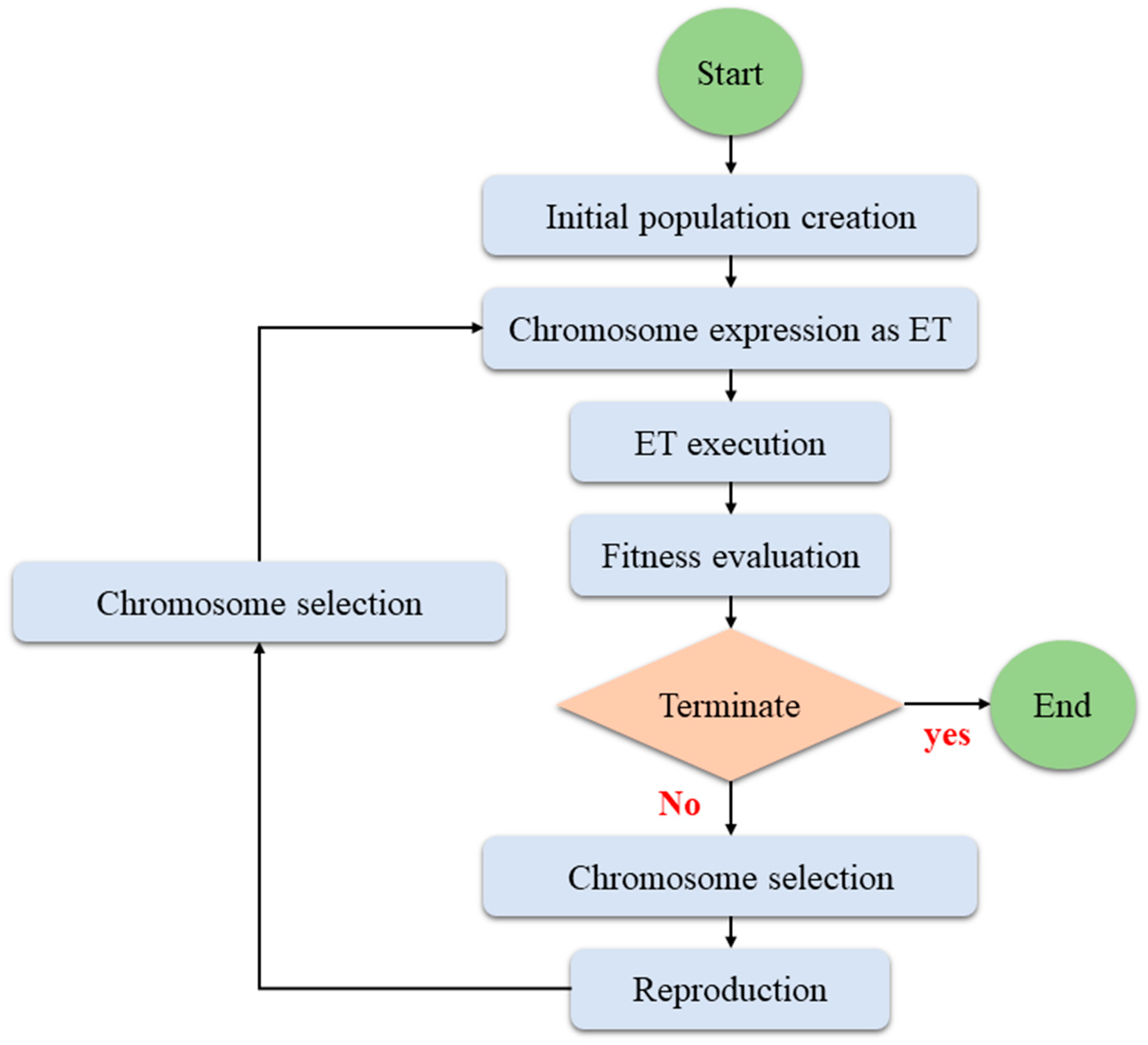
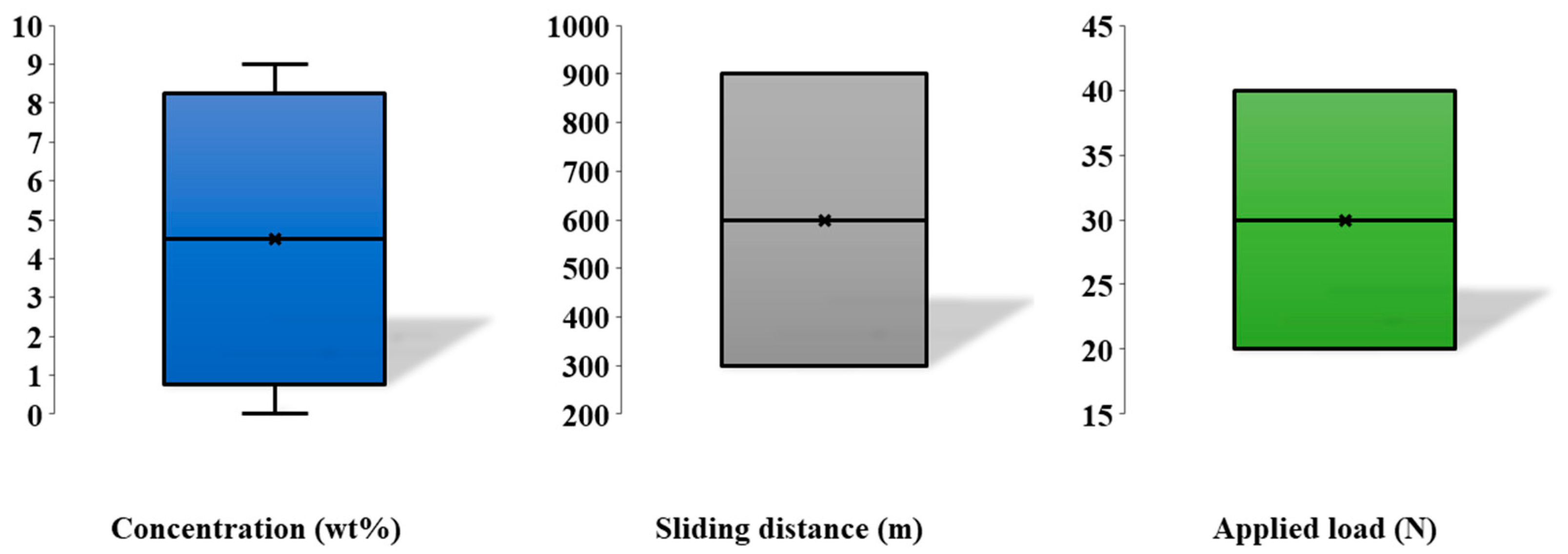

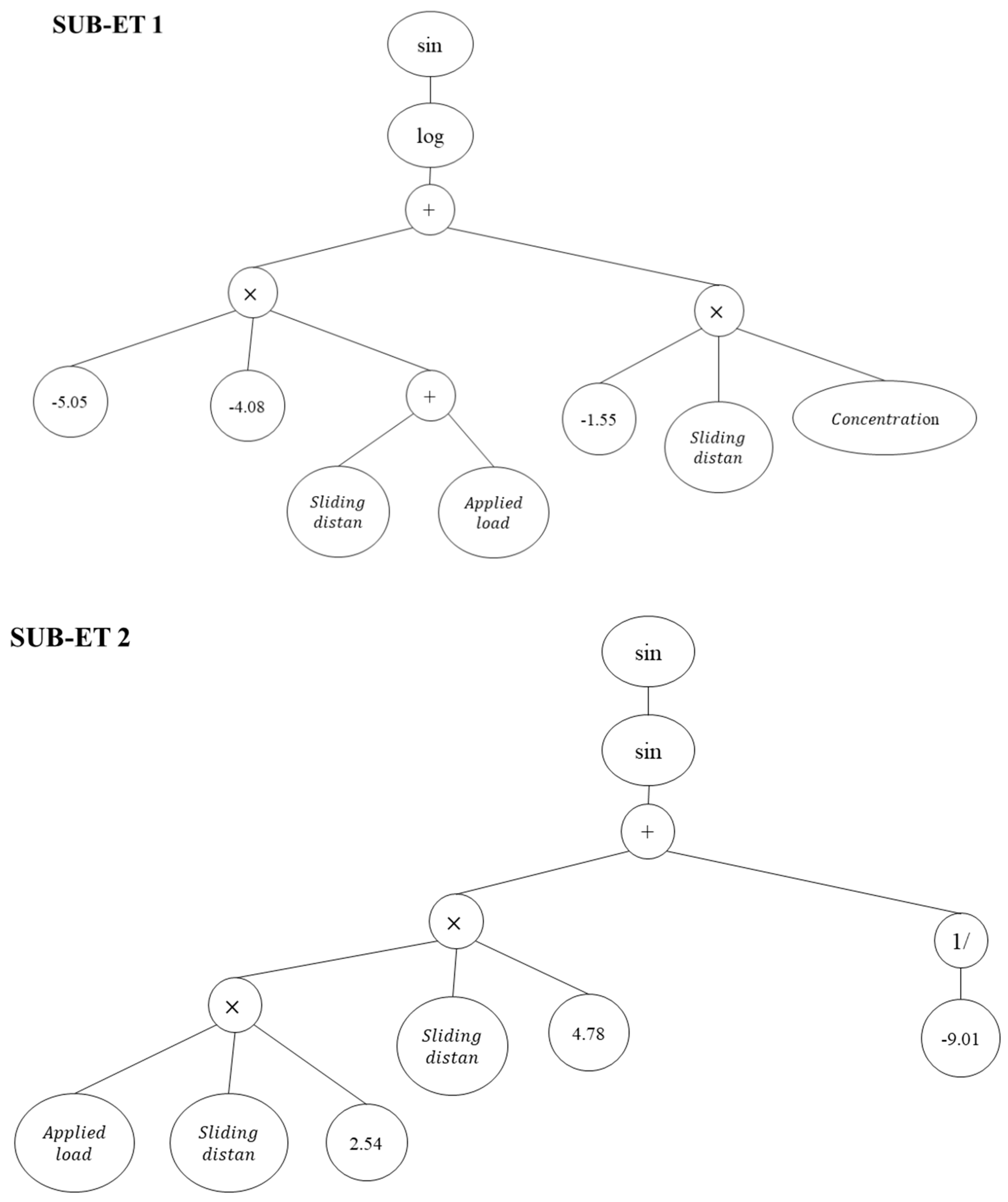
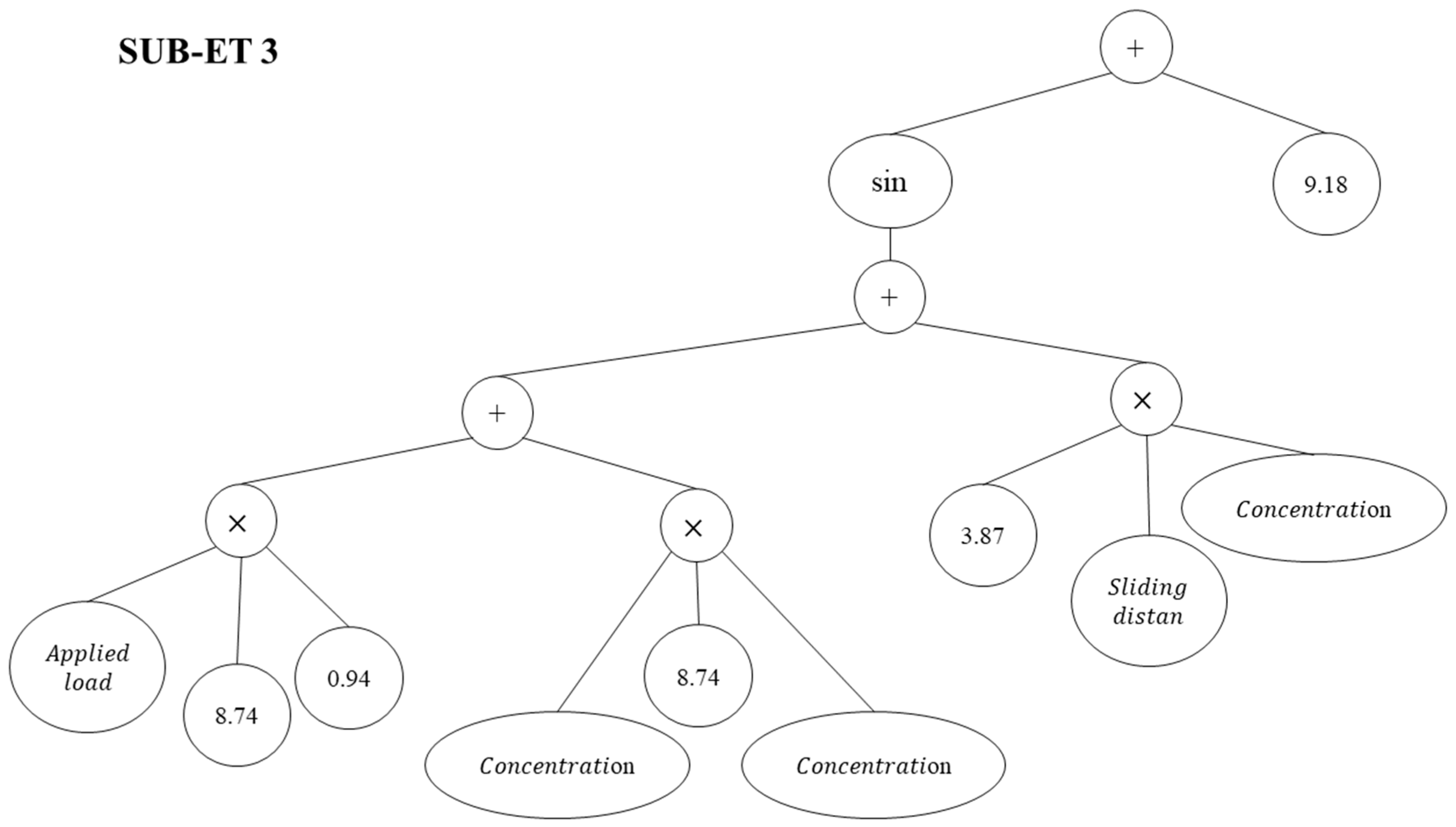
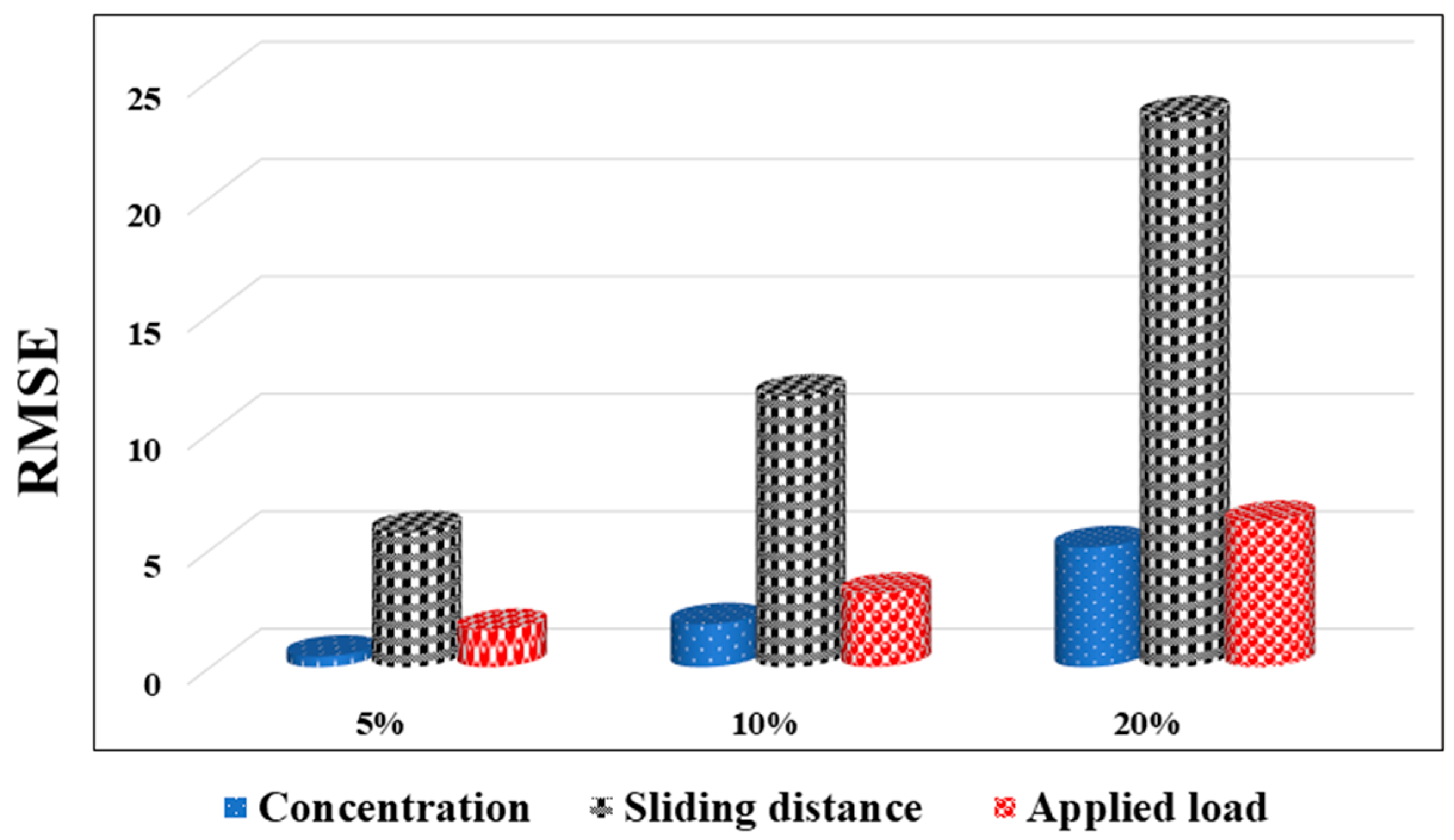
| Concentration (wt%) | Sliding Distance (m) | Applied Load (N) |
|---|---|---|
| 0, 3, 6, 9 | 300, 600, 900 | 20, 40 |
| Chromosomes number | 30 |
| Head size | 7.8 |
| Genes number | 3, 4 |
| Linking function | Addition (+), Multiplication () |
| Fitness function error type | RMSE |
| Constant per gene | 1 |
| Mutation rate | 0.044 |
| Inversion rate | 0.1 |
| One-point recombination rate | 0.3 |
| Two-point recombination rate | 0.3 |
| Gene recombination rate | 0.1 |
| Code | Function Set |
|---|---|
| S1 | +, , /, −, |
| S2 | +, , x2, Sqrt |
| S3 | +, sin, log, 1/x |
| S4 | −, Sqrt, log, 1/x, x2, sin, |
| No. | Head Size | Number of Genes | Linking Function | Function Set | Training | Testing | |||||
|---|---|---|---|---|---|---|---|---|---|---|---|
| R2 | RMSE | RRSE | R2 | RMSE | RRSE | ||||||
| GEP-1 | w1 | 7 | 3 | S1 | 0.9451 | 0.4357 | 0.2342 | 0.9649 | 1.0906 | 0.3353 | |
| w2 | 7 | 3 | S1 | 0.9677 | 0.3343 | 0.1797 | 0.9828 | 0.8902 | 0.2737 | ||
| w3 | 8 | 3 | S1 | 0.9485 | 0.4218 | 0.2267 | 0.9436 | 1.1465 | 0.3525 | ||
| w4 | 8 | 3 | S1 | 0.9690 | 0.3274 | 0.1760 | 0.9962 | 0.4007 | 0.1233 | ||
| w5 | 7 | 4 | + | S1 | 0.9747 | 0.2955 | 0.1589 | 0.9973 | 0.3563 | 0.1095 | |
| w6 | 7 | 4 | S1 | 0.9762 | 0.2873 | 0.1544 | 0.9908 | 0.6120 | 0.1882 | ||
| GEP-2 | w1 | 7 | 3 | S2 | 0.9471 | 0.4318 | 0.2321 | 0.9823 | 0.8175 | 0.2513 | |
| w2 | 7 | 3 | S2 | 0.9517 | 0.4091 | 0.2199 | 0.9757 | 0.8067 | 0.2480 | ||
| w3 | 8 | 3 | + | S2 | 0.9658 | 0.3612 | 0.1942 | 0.9801 | 0.7394 | 0.2273 | |
| w4 | 8 | 3 | S2 | 0.9372 | 0.5564 | 0.2991 | 0.9792 | 0.8205 | 0.2552 | ||
| w5 | 7 | 4 | + | S2 | 0.9425 | 0.4468 | 0.2402 | 0.9750 | 0.7548 | 0.2321 | |
| w6 | 7 | 4 | S2 | 0.9584 | 0.3795 | 0.2040 | 0.9798 | 0.6948 | 0.2136 | ||
| GEP-3 | w1 | 7 | 3 | + | S3 | 0.9740 | 0.3115 | 0.1674 | 0.9522 | 1.0163 | 0.3125 |
| w2 | 7 | 3 | S3 | 0.9703 | 0.3221 | 0.1731 | 0.9931 | 0.4003 | 0.1231 | ||
| w3 | 8 | 3 | + | S3 | 0.9685 | 0.3462 | 0.1861 | 0.9607 | 1.009 | 0.3103 | |
| w4 | 8 | 3 | S3 | 0.9840 | 0.2357 | 0.1267 | 0.9864 | 0.7831 | 0.2408 | ||
| w5 | 7 | 4 | + | S3 | 0.9703 | 0.3296 | 0.1772 | 0.9758 | 1.0485 | 0.3224 | |
| w6 | 7 | 4 | S3 | 0.9768 | 0.2847 | 0.1531 | 0.9831 | 0.6950 | 0.2137 | ||
| GEP-4 | w1 | 7 | 3 | S4 | 0.9677 | 0.3348 | 0.1800 | 0.9828 | 0.7591 | 0.2334 | |
| w2 | 7 | 3 | S4 | 0.9480 | 0.4367 | 0.2347 | 0.9633 | 0.7668 | 0.2358 | ||
| w3 | 8 | 3 | + | S4 | 0.9422 | 0.5103 | 0.2743 | 0.9580 | 1.2254 | 0.3768 | |
| w4 | 8 | 3 | S4 | 0.9538 | 0.4005 | 0.2153 | 0.9794 | 0.6767 | 0.2081 | ||
| w5 | 7 | 4 | + | S4 | 0.9608 | 0.4438 | 0.2386 | 0.9750 | 1.1326 | 0.3482 | |
| w6 | 7 | 4 | S4 | 0.9314 | 0.4890 | 0.2629 | 0.9895 | 0.4853 | 0.1492 | ||
Publisher’s Note: MDPI stays neutral with regard to jurisdictional claims in published maps and institutional affiliations. |
© 2022 by the authors. Licensee MDPI, Basel, Switzerland. This article is an open access article distributed under the terms and conditions of the Creative Commons Attribution (CC BY) license (https://creativecommons.org/licenses/by/4.0/).
Share and Cite
Abbasi, H.; Zeraati, M.; Moghaddam, R.F.; Chauhan, N.P.S.; Sargazi, G.; Di Lorenzo, R. Gene Expression Programming Model for Tribological Behavior of Novel SiC–ZrO2–Al Hybrid Composites. Materials 2022, 15, 8593. https://doi.org/10.3390/ma15238593
Abbasi H, Zeraati M, Moghaddam RF, Chauhan NPS, Sargazi G, Di Lorenzo R. Gene Expression Programming Model for Tribological Behavior of Novel SiC–ZrO2–Al Hybrid Composites. Materials. 2022; 15(23):8593. https://doi.org/10.3390/ma15238593
Chicago/Turabian StyleAbbasi, Hossein, Malihe Zeraati, Reza Fallah Moghaddam, Narendra Pal Singh Chauhan, Ghasem Sargazi, and Ritamaria Di Lorenzo. 2022. "Gene Expression Programming Model for Tribological Behavior of Novel SiC–ZrO2–Al Hybrid Composites" Materials 15, no. 23: 8593. https://doi.org/10.3390/ma15238593
APA StyleAbbasi, H., Zeraati, M., Moghaddam, R. F., Chauhan, N. P. S., Sargazi, G., & Di Lorenzo, R. (2022). Gene Expression Programming Model for Tribological Behavior of Novel SiC–ZrO2–Al Hybrid Composites. Materials, 15(23), 8593. https://doi.org/10.3390/ma15238593








